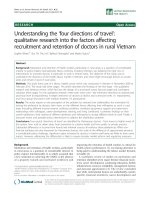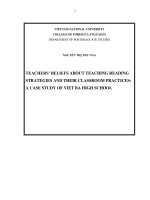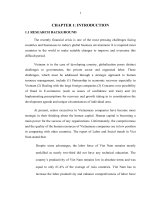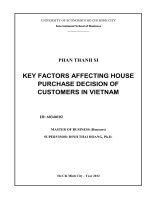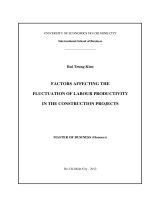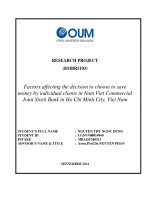Factors affecting the helping behaviors of employees in ivac
Bạn đang xem bản rút gọn của tài liệu. Xem và tải ngay bản đầy đủ của tài liệu tại đây (985.38 KB, 59 trang )
RESEARCH PROJECT
(BMBR5103)
FACTORS AFFECTING
THE HELPING BEHAVIORS OF EMPLOYEES
IN IVAC
STUDENT’S FULL NAME
: CHE THI ANH NGUYET
STUDENT ID
: CGS00018254
INTAKE
: MAY, 2014
ADVISOR’S NAME AND TITLE : DR. NGUYEN THE KHAI
August, 2015
Page 0
Advisor’s assessment
..............................................................................................................................................................
..............................................................................................................................................................
..............................................................................................................................................................
..............................................................................................................................................................
..............................................................................................................................................................
..............................................................................................................................................................
..............................................................................................................................................................
..............................................................................................................................................................
..............................................................................................................................................................
..............................................................................................................................................................
..............................................................................................................................................................
..............................................................................................................................................................
..............................................................................................................................................................
..............................................................................................................................................................
..............................................................................................................................................................
..............................................................................................................................................................
..............................................................................................................................................................
________________
Advisor’s signature
Page 1
TABLE OF CONTENTS
LIST OF TABLE.......................................................................................................4
ABSTRACT ...............................................................................................................5
CHAPTER 1 – INTRODUCTION ..........................................................................6
1.1
COMPANY BRIEF INTRODUCTION ...................................................6
1.1.1. Name of the Company .............................................................................6
1.1.2. Headquarters ............................................................................................6
1.1.3. The structure of organization and management of the company. .....10
1.1.4. Characteristics of this particular company model ..............................11
1.1.5. Directorate, Councils and Officials.......................................................16
1.2
RESEARCH PROBLEM STATEMENT ..............................................18
1.3
SCOPE OF THE RESEARCH ...............................................................18
1.4
SIGNIFICANCE OF RESEARCH.........................................................18
CHAPTER 2 – LITERATURE REVIEW ............................................................19
2.1
DEFINITION OF CONSTRUCT ...........................................................19
2.1.1. Helping Behaviors .................................................................................19
2.1.2. Perceived Person-Organization Fit.......................................................20
2.1.3. Supervisory Support ..............................................................................21
2.1.4. Procedural Justice ..................................................................................22
2.1.5. Overall Job Satisfaction .........................................................................22
Chapter 3: RESEARCH MODEL AND HYPOTHESES ...................................24
3.1.
RESEARCH MODEL ..............................................................................24
3.1.1. Dependent Variables: ...........................................................................24
3.1.2. Independent Variables: ........................................................................24
3.2.
RESEARCH HYPOTHESES: ................................................................25
3.3.
DATA COLLECTION.............................................................................25
3.4.
MEASURE OF EACH CONSTRUCT ...................................................25
3.4.1. Helping Behaviors.................................................................................25
3.4.2 Perceived Person-Organization Fit .....................................................27
Page 2
3.4.3 Supervisory Support .............................................................................29
3.4.4 Procedural Justice ................................................................................30
3.4.5 Overall Job Satisfaction .......................................................................32
Chapter 4: RESULTS AND FINDINGS ...............................................................35
4.1
RELIABILITY STATISTIC ...................................................................35
4.2
DESCRIPTIVE STATISTIC ..................................................................35
4.3
HYPOTHESIS TESTING RESULT: .....................................................36
Chapter 5: DISCUSSION .......................................................................................39
REFERENCE ..........................................................................................................41
APPENDIX ..............................................................................................................45
Page 3
LIST OF TABLE
Table 1: Measurement of Helping Behaviors…………………………....
27
Table 2: Measurement of Perceived Person-Organization Fit…………… 28
Table 3: Measurement of Supervisory Support………………………….
30
Table 4: Measurement of Procedural Justice…………………………….
32
Table 5: Measurement of Overall Job Satisfaction………………………. 33
Table 6: Reliability statistics…………………………………………….
35
Table 7: Descriptive statistics……………………………………………
36
Table 8: Model Summary………………………………………………... 36
Table 9: Coefficients a…………………………………………………… 37
Page 4
ABSTRACT
The purpose of the study is to discuss factors affecting to the helping behaviors of
employees in Institute of Vaccines and Medical Biologicals (IVAC) through a
questionnaire.
This study analyses whether or not there are the significant relationships between
Perceived Person-Organization Fit and Helping Behaviors, Supervisory Support and
Helping Behaviors, Procedural Justice and Helping Behaviors, Overall Job
Satisfaction and Helping Behaviors in IVAC
The theoretical framework of this study was tested by collecting data from
employees in IVAC. Questionnaires were given personally to 308 employees; in
which 275 questionnaires were returned and used for the statistical analysis. The
reliability analysis, descriptive analysis, and hypothesis testing were employed to
analyze the data.
Although there are some limitations, the research outcomes are expected to be a
possibly constructive source for IVAC to refer in building strategies and polities to
enhance helping behaviors among employees.
Keywords: Helping Behavior, Perceived Person-Organization Fit, Supervisory
Support, Procedural Justice, Overall Job Satisfaction
Page 5
CHAPTER 1 – INTRODUCTION
1.1
COMPANY BRIEF INTRODUCTION
1.1.1. Name of the Company
-
Vietnamese name: Vien Vac xin va Sinh pham Y te
-
English name: Institute of Vaccines and Medical Biologicals
-
Abbreviation: IVAC
1.1.2. Headquarters
-
Address: 9 Pasteur Street, Nha Trang City, Khanh Hoa province, Vietnam
-
Phone: (84.58) 3822408
-
Fax: (84.58) 3823815
-
Website: www.ivac.com.vn
-
Email:
IVAC is a non-business unit which self-finance all or part of its operations, under
the Ministry of Health. It was founded under the Minister of Health‟s Decision No.
1395 BYT/QD dated November 23, 1978 and rearranged under the Government‟s
Decree No. 49/2003/ND-CP dated May 15, 2003 and the Prime Minister‟s
Page 6
Decision No. 621/QD-TTg dated April 18, 2006.
Since 1990, IVAC has successfully produced and sell Diptheria-Tetanus-Pertussis
vaccine, Tetanus vaccine, and vaccine for Tuberculosis to the Expanded Programme
on Immunization. Nowadays, There are 13 kinds of vaccine have been produced in
IVAC.
IVAC has built its facilities to become a relatively complete and integrated
production unit from additional technical services to main production lines. It has a
large breeding farm for laboratory animals and crucial source technology with
modern equipment for important functions such as: biofermentation technology;
freeze-drying technology; antigen and antibody purifications; serum preparation
technology from horses - plasmapheresis; vaccine fill - finish technology;
production technology of influenza vaccine based on embryonated chicken egg;
microbiological, chemical-immune techniques and cell culture for quality control of
products.
Functions: IVAC has such functions as research, manufacture, business,
consultancy and service, cooperation in vaccines and medical biologicals; personnel
training.
Responsibilities:
-
Scientific and technological research
-
Doing research and applying scientific and technological advances in the
production of vaccines and medical biologicals.
-
Trial production, technological transfer, investment cooperation in
developing new vaccines and medical biologicals with domestic and foreign
individuals and organizations.
-
Making scientific research theses of all levels
-
Involved in making and giving directions for the use of vaccines and
medical biologicals
Page 7
Production, business, consultancy and service operation
-
Production of vaccines, sera and medical biologicals for domestic supply
and export.
-
Business, import, export of semi finished and finished products of vaccines
and medical biologicals
-
Consultancy and service operation, including injection relevant to vaccines
and medical biologicals within the competence of IVAC.
Training
-
Post-graduate training: involved in post-graduate education for masters‟
degrees, PhD degrees (in cooperation with universities) in such specialties
as epidemiology, medical microbiology, immunology, biotechnology and
other specialties in accordance with the law;
-
Involved in graduate education at universities, colleges and high schools
specialized in epidemiology, medical microbiology, immunology and
biotechnology;
-
Retraining and sharpening technical staffs professional skills.
-
Compiling materials for teaching, reference books, preventive health
magazines and disseminating specialist knowledge.
International cooperation
-
Establishing and maintaining the relationships with countries, governmental
and nongovernmental organizations and individuals in the region and
around the world in the training and research in the field of vaccines and
medical biologicals in accordance with the law;
-
Making plans and organizing the implementation of international
cooperation programs and projects on vaccines and medical biologicals;
seeking for international aid in the fields of scientific research, labor
Page 8
training, basic construction and equipment supply prescribed by the law;
-
Organizing and co-organizing training courses, workshops and international
scientific seminars within the framework of law;
-
Making plans for delegates under the international cooperation programs
with IVAC; sending staff to attend training courses or do research abroad
and receiving foreign trainees to do research and exchange experience at
IVAC in accordancc to the lawful regulations on international cooperation.
IVAC must be responsible in law for the workforce sent or allowed by
IVAC to go abroad and for the management of the delegates‟ arrival and
departure.
Management:
-
Giving direction on and supervising the operation of enterprises under
IVAC founded in accordance to the law;
-
Making and implementing operation regulations of IVAC prescribed by the
law;
-
Managing and using effectively all resources. The staff, salaries, finance
and equipment of IVAC are managed in accordance with law;
-
Implementing the lawful regulations on the state budget revenue and
expenditure of IVAC;
-
Establish State enterprises under IVAC when needed to produce and trading
in vaccines and medical biologicals and provide scientific and technical
services related to the functions and responsibilities of IVAC prescribed by
the law;
-
Implementing scientific, technical and preventive health services in its
allowed scope of specialty, developing domestic and international
cooperation projects prescribed by the law to support professional activities
and raise funds for IVAC to improve its staff s living standards;
Page 9
-
Making reports on all the activities of IVAC in accordance with the law.
1.1.3. The structure of organization and management of the company.
Director
Moral council
Scientific council
Logistics
Vice Director
directoror
Production
Vice Director
Quality
Vice Director
Personnel and
Administration
DPT vaccine
Department
Quality Assurance
Department
Planning and
Finance
BCG vaccine
Department
Quality Control
Department
Sales
Department
Sera
Department
Research and
Development
Supply
Department
Final Product
Department
Equipment
technique
Media
Department
Suoi Dau
Breed Farm
Influenza vaccine
Department
Probiotic
Department
P a g e 10
Total IVAC‟ s manpower: 328 persons
Bachelor :
32,6%
Master & PhD:
20 persons
Ass. Professor:
2 persons
Technician:
most skilled technician
Average age: ≤ 40: 51%; ≤ 50: 43%; < 60: 6%.
This is the strength of IVAC with the experienced, qualified team in producing,
controlling, managing vaccines as well as in breeding animals for quality control. In
current 5 years, 200 staffs have been educated at some developed countries to
upgrade technical/professional skills and Quality Assurance knowledge.
1.1.4. Characteristics of this particular company model
IVAC has authority to autonomy and self-responsibility for implementing the
government‟s Decree 43/2006/ND-CP.
IVAC is responsible for being led and managed by the Minister of Health and
technically directed in by State authorities.
IVAC is allowed to cooperate with agencies and individuals inside and outside the
medical department from central to local levels to implement functions and
responsibilities assigned by the Minister of Health.
IVAC may cooperate with foreign organizations and individuals in the fields
assigned by the Minister of Health and abide by international cooperation
regulations on healthcare.
IVAC is under the territorial management of the provincial peoples‟ committees of
Khanh Hoa in accordance with the law and takes responsibility for cooperation
with the local and relevant organizations to fulfill assigned functions and tasks.
IVAC is entitled to:
P a g e 11
-
Decide on property procurement, investment in construction of material
foundations with non-business operation development funds and mobilized
capital according to the plans approved by the Minister of Health
authorities; participate in bidding for service activities in accordance with
its professional domains; use property for joint venture, cooperation or
contribute capital to joint-ventures with domestic and foreign organizations
and/or individuals for construction investment, procurement of machinery
and equipment for service activities.
-
Decide on its payroll; to sign labor-hiring or package contracts for the
performance of jobs which need no regular staffs on the payroll, to sign
contracts or other forms of cooperation with domestic and foreign experts
as well as scientists so as to meet the IVAC‟s professional requirements.
-
Decide on recruitment of cadres and civil servants through examination or
consideration; decide on appointment of civil servants (for titles equivalent
to senior experts or lower titles), sign working contracts with recruits who
satisfy all criteria of the concerned ranks and are compatible with the
structure of professional titles; decide on mobilization, detachment,
retirement, job severance, termination of working contracts, commendation
or discipline of cadres and civil servants under IVAC management; decide
on the raising of salary grades on time or ahead of time for cadres and civil
servants in the same rank and receive, transfer holders of titles equivalent to
senior experts or lower titles; decide to invite foreign specialists for
professional jobs, send its cadres to work or study abroad in order to raise
IVAC‟s professional qualifications.
IVAC must register, declare and pay all taxes and other amounts (if any), enjoy tax
exemption or reduction.
IVAC may borrow capital from credit institutions, mobilize capital from its cadres
and civil servants for investment in expansion and raising of quality operations,
P a g e 12
organization of service activities in line with its functions and tasks, and have to pay
debts by itself.
IVAC has a legal status and a private stamp with an account at the State Bank and
Treasury.
Financial source of IVAC is from:
-
State budget allocations for: performance of scientific and technological
tasks; implementation of personnel training programs; implementation of
national target programs; performance of orders placed by competent state
agencies (investigation, planning, survey or other tasks); performance of
urgent tasks assigned by competent authorities; implementation of the
policy on payroll streamlining under the state regime; construction
investment, procurement of equipment, overhaul of fixed assets in service
of non-business operations according to projects approved by competent
authorities within the annually-assigned estimates; and reciprocal capital for
implementation of projects funded with foreign capital sources which have
been approved by competent authorities;
-
Revenues from operations, including: the revenue from service activities;
the revenue from other operations; profits gained from joint-venture or
cooperation activities, interests on bank deposits.
-
Aids, financial supports, gifts, presents and donations provided for by law.
-
Other sources, including: capital borrowed from credit institutions, capital
mobilized from cadres and civil servants within the units; and joint-venture
and cooperation capital of domestic and foreign organizations and
individuals provided for by law.
Expenditure of IVAC include:
a) Regular expenditures, including:
-
Salaries and allowances
P a g e 13
-
Operations according to the functions and tasks;
-
Service activities (including those on fulfillment of obligations towards the
state budget, fixed asset depreciation under regulations, and payment of
loan principals and interests according to the provisions of law).
b) Irregular expenditures, including:
-
Performance of scientific and technological tasks;
-
Implementation of personnel training and fostering programs;
-
Implementation of national target programs;
-
Performance of orders placed by the State (investigation, planning, survey
or other tasks) according to prices or price brackets set by the State;
-
Reciprocal capital for implementation of projects funded with foreign
capital sources according to regulations;
-
Performance of urgent tasks assigned by the Ministry of Health authorities;
-
Payroll streamlining according to the state-prescribed regime;
-
Capital construction investment, procurement of equipment, overhaul of
fixed assets for implementation of projects approved by the Ministry of
Health authorities;
-
Implementation of projects funded with foreign aids;
-
Joint venture and cooperation activities;
-
Expenses for rewards;
-
Other expenditures under regulations.
Management of assets, materials, equipment and basic construction in IVAC:
-
Every year, IVAC uses the current fund for maintaining, repairing and
testing equipment and machinery; upgrading and improving the
infrastructures of IVAC.
P a g e 14
-
With regard to fixed assets used in service activities, depreciation must be
made to recover capital. IVAC may retain fixed asset depreciation sums and
proceeds from the liquidation of assets belonging to the state budget for
supplementation of non-business operation development funds.
-
Fixed asset depreciation sums and proceeds from the liquidation of assets
belonging to loan capital sources shall be used for debt payment. Where all
debts have been paid, IVAC may retain the remainder for supplementation
of its non-business operation development funds.
With regard to activities of performing the functions and tasks assigned by the
State, IVAC shall calculate expenditures on wage and remuneration paid to its
cadres, civil servants and laborers according to the rank and position-based wage
levels stipulated by the State
Annually, after paying expenditures, taxes and fulfilling other financial obligations
under regulations, the units shall be entitled to use positive differences between
revenues and expenditures in the following order:
-
Deducting at least 25% for setting up the nonbusiness operation
development fund;
-
Paying increased incomes to laborers. The payment of increased incomes to
laborers comply with the principle that who work with higher productivity
and make more contributions to increasing revenues and reducing
expenditures shall be paid more than others.
-
Making deductions for setting up the reward fund, the welfare fund and the
reserve fund for income stabilization. With regard to the reward fund and
the welfare fund, the maximum deduction level shall not exceed the average
of 3 months' increased wages, remunerations and incomes actually paid in
the year.
Every year, IVAC must estimate revenues, expenditures; manage and use sources
P a g e 15
of existing funds in accordance with the law. The director is responsible for
reporting the general estimate and account in accordance with the law in force.
IVAC must make financial disclosure in accordance with the law.
IVAC executes self-examination and supervision activities according to
assignments and level; and is under supervision of the Ministry of Health and State
authorized agencies.
1.1.5. Directorate, Councils and Officials
a) Directorate
There are 4 members (the director and 3 vice directors) in directorate. They are
appointed, re-appointed and dismissed by the Minister of Health according to the
law. They are accountable before their immediate superior agencies and before law
for his decisions in exercising the right to autonomy with regard to the tasks,
organizational apparatus, payroll and finance of IVAC.
Duties of Directorate
-
To organize the implementation of the State's regulations on environmental
protection, security, social order, maintenance of safety and state secrets in
IVAC‟s operations. To fulfill obligations towards the State and implement
preferential policies towards policy beneficiaries.
-
To elaborate plans for exercise of the right to autonomy and selfresponsibility according to the provisions of this Decree and report them to
superior agencies.
-
To elaborate and organize the implementation of internal spending
regulations under the guidance of the Finance Ministry.
-
To organize the management and use of cadres and civil servants according
to the provisions of law; ensure regimes for, and interests of, laborers in
terms of wages, remunerations, social insurance, health insurance,
P a g e 16
professional training and retraining in accordance with the provisions of
law.
-
To organize the bookkeeping accounting, statistics, management of assets
in strict compliance with the provisions of law, reflecting fully and
promptly all revenues and expenditures of the units in accounting books. To
comply with the regulations on the regime of information and reporting on
nonbusiness operations of the units in accordance with current regulations.
-
To observe regulations on grassroots democracy and financial publicity in
accordance with current regulations.
-
To implement the State's and Party's regulations on activities of Party and
mass organizations. To be responsible for coordinating with, and creating
conditions for, Party and mass organizations to join in supervision and
management of all aspects of the units' operations.
b) Councils
There are 2 councils in IVAC. The scientific council and the moral council in
medical and biological research provide advice for the director on the strategy on
scientific and technological research, personnel training and preventive health
service.
The organization and operation of the scientific council and the moral council in
medical and biological research adhere to the regulations of the Ministry of Science
& Technology and the Ministry of Health.
c) Officials
The officials of IVAC are recruited and appointed to a classification scale
prescribed by the law.
They have the right to be provided favorable working conditions, appointed to
work positions suitable to their ability and competence, further training to improve
their professional skills, attend an exam to get higher classification scales when
P a g e 17
eligible and enjoy all the rights prescribed by the law.
1.2
RESEARCH PROBLEM STATEMENT
IVAC is the largest manufacturer of vaccines and sera in Vietnam.
To maintain its competitive position, IVAC has equipped itself a staff of highly
qualified and experienced.
However, in recent years many skilled and experienced employees have reached
retirement age so IVAC has to recruit new employees.
There is not any university in Vietnam has specialized training in vaccine and
serum production. Therefore, it is necessary to identify the factors influence
helping behavior that helps IVAC greatly reduces the cost of training abroad.
1.3
SCOPE OF THE RESEARCH
This study was conducted on all employees of IVAC with managers
excepted. Each employee was sent with a questionnaire to fill in.
1.4
SIGNIFICANCE OF RESEARCH
This study examined the relationships between Perceived Person-Organization Fit
and Helping Behaviors, Supervisory Support and Helping Behaviors, Procedural
Justice and Helping Behaviors, Overall Job Satisfaction and Helping Behaviors in
IVAC
With the results of study, the managers of the IVAC could adjust strategies and
policies to strengthen helping behaviors. This study could also serve as a reference
for other managers to improve helping behaviors for their department.
P a g e 18
CHAPTER 2 – LITERATURE REVIEW
2.1
DEFINITION OF CONSTRUCT
2.1.1. Helping Behaviors
Helping behavior refers to voluntary actions intended to help the others, with
reward regarded or disregarded. It is a type of prosocial behavior (voluntary action
intended to help or benefit another individual or group of individuals, such as
sharing, comforting, rescuing and helping).
According to Penner, Louis A., John F. Dovidio, Jane A. Piliavin, and David A.
Schroeder. (2005) humans‟ survival relied strongly on the processes of giving and
helping. Those who displayed prosocial dispositions were thus met with
evolutionary success. Group selection evinces that if two groups are in direct
competition with one another, the group with the larger number of altruists will
have an advantage over a group of mainly selfish individuals. Kin selection theory
is one perspective on helping behavior. In this theory, helping behavior psychology
can be due to evolution. Natural selection contributes to the survival idea, and
humans are screened out of the evolution process if they lack the ability to adapt to
environmental changes. To survive among groups of people with a similar genetic
composition, desirable behaviors are maintained.
A second perspective is called negative-state relief model helping behavior that
people help because of egoism. Egoistic motives lead one to help others in bad
circumstances in order to reduce personal distress experienced from knowing the
situation of the people in need. Helping behavior happens only when the personal
distress cannot be relieved by other actions. The model explains also people‟s
avoidance behavior from people in need: this is another way of reducing distress.
Fultz J., Schaller M., and Cialdini R.B. (1988) found that people who are
anticipating positive events (listening to a comedy tape), will show low helping
P a g e 19
motivation since they are expecting their negative emotions to be lifted up by the
upcoming stimulation.
Empathy-altruism is the theory that helping behavior is triggered by empathy. As
Gilovich T., Keltner D., and Nisbett R.E. (2006) Helping behavior may be initiated
when we feel empathy for the person, that is, identifying with another person and
feeling and understanding what that person is experiencing.
Reciprocal helping behavior is a fourth perspective. In general, people help others
without the thought of personal gains that may occur as a result. This theory states
that people think about future benefits for themselves when they help others, as long
as the benefit will outweigh the sacrifice. Future benefits can include similar
repayment by the person being helped. As Trivers R. (1971) the incentive for an
individual to help in the present is based on the expectation of the potential receipt
in the future. He believes it to be advantageous for an organism to pay a cost to his
or her own life for another non-related organism if the favor is repaid (only when
the benefit of the sacrifice outweighs the cost).
The final perspective of helping behavior is the social exchange theory, people help
because they want to gain goods from the one being helped. According to Foa U.
G., and Foa E. B. (1975) People calculate rewards and costs of helping others, and
aim at maximizing the former and minimizing the latter, which is known as a
“minimax” strategy. Rewards are either external or internal. External reward is
things that obtained from others when helping them, for instance, friendship and
gratitude. Internal reward is generated by oneself when helping, for example, sense
of goodness and self-satisfaction.
2.1.2. Perceived Person-Organization Fit
Person–organization fit is defined by Kristof A.L. (1996) as, "the compatibility
between people and organizations that occurs when at least one entity provides what
the other needs, they share similar fundamental characteristics, or both".
P a g e 20
According to Gregory (2010) individuals are attracted to and seek to work for
organizations where they perceive high levels of person–organization fit.
Greguras G. J., and Diefendorff J. M. (2009); Liu B., Liu J., and Hu J. (2010);
Rehfuss M. C., Gambrell C. E., and Meyer D. (2012) defined person-organization
fit in which fit was broken into three categories: One category was personorganization fit which was defined as the "congruence between employees' personal
values and an organizations culture." Another category was demands-abilities fit
and referred to the "correspondence between employee skills and demands of the
job;" this category was also referred to as person-job fit. The third category was
needs-supplies fit that measured the "extent to which employees' needs and tangible
rewards match"
2.1.3. Supervisory Support
Supervisor support is defined as employees‟ belief concerning the extent to which
supervisors value their contributions and care about their well-being. Employees
need motivation to expend greater efforts and more personal resources in innovative
tasks when supervisor exhibit their individual consideration toward followers,
followers are likely to perceive the warmth and consideration from their
supervisors.
As Eisenberger R., Huntington R., Hutchison S., and Sowa D., (1986) employees
who perceive support from their supervisors often feel obligated to pay back
supervisors‟ favors or kindness by helping supervisors to reach their stated goals.
Zhou J., and Shalley C. E. (2003) indicated that leadership is positively associated
with employee-perceived empowerment and support for innovation.
According to Shalley C.E., Zhou J., and Oldham G.R. (2004) Creativity and
innovation is an area where supervisors can have a strong impact on employee
creativity through their influence on the context within which employees work. In
P a g e 21
order for innovative behavior to occur, supervisor needs to foster, encourage, and
support creativity
2.1.4. Procedural Justice
Procedural justice is the idea of fairness in the processes that resolve disputes and
allocate resources.
As Tom R. Tyler (1990) fair procedure leads to equitable outcomes, even if the
requirements of distributive or restorative justice are not met.
According to Morton Deutsch (2011) fair procedures are the best guarantee for fair
outcomes. Procedural justice is concerned with making and implementing decisions
according to fair processes. People feel affirmed if the procedures that are adopted
treat them with respect and dignity, making it easier to accept even outcomes they
do not like.
Decisions should be reached through open procedures, without secrecy or
deception. William Nelson (1980) believes that procedural justice is not enough.
Reaching fair outcomes is far more important than implementing fair processes.
2.1.5. Overall Job Satisfaction
There are many aspects to job satisfaction, depending on what each individual
person feels is important.
Locke, E.A. (1976) defines job satisfaction as: “the pleasurable emotional state
resulting from the appraisal of one‟s job as achieving or facilitating the achievement
of one‟s job values
Spector, P.E. (1997) describe job satisfaction as: “the extent to which people like
(satisfaction) or dislike (dissatisfaction) their jobs"
As Lu H., While A.E., and Barriball K.L. (2005) Job satisfaction cover the affective
feeling an employee has towards their job. This could be the job in general or their
P a g e 22
attitudes towards specific aspects of it, such as: their colleagues, pay or working
conditions.
Luthans F. (1992) indicated that the extent to which work outcomes meet or exceed
expectations may determine the level of job satisfaction.
P a g e 23
Chapter 3: RESEARCH MODEL AND HYPOTHESES
3.1.
RESEARCH MODEL
Perceived PersonOrganization Fit
+
H1
Supervisory Support
+
+
Procedural Justice
H2
H3
Helping Behaviors
H4
+
Overall Job
Satisfaction
Figure 1: Proposed research model of Helping Behaviors among employees in
IVAC
3.1.1. Dependent Variables:
Helping Behaviors
3.1.2. Independent Variables:
-
Perceived Person-Organization Fit
-
Supervisory Support
P a g e 24
